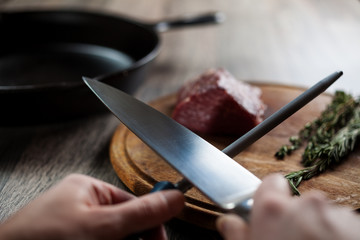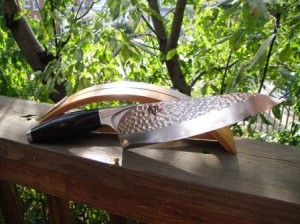Knives
Knives
The most exciting part of cooking school was when we received our knife-kits.
“Be careful, the knives in your kits are new and very sharp,” our chef instructor told us.
That didn’t keep several students from cutting themselves during our first week of instruction. It also didn’t dissuade one of my classmates from cutting herself, passing out with the knife in her hand, and stabbing the chef in the leg as she fell to the ground.
Knife Safety
Knives are the most used tool in the kitchen, and can also be dangerous if not used correctly. Here are a few tips and techniques you can implement to help keep your working area safe.
Keep Your Knives Sharp!
If your knives aren’t sharp, you can run into real problems. Dull knives slide off food, and tend to end up cutting fingers and hands. You can keep your knives sharp by using a honing, or sharpening steel. A steel is a long, pointed steel tool that helps maintain the edge on knives. To use, place the steel in your left hand if you’re right-handed, and your knife in the other hand. Run the blade along the steel at a 45 degree angle on both sides until the knife becomes sharp. This takes some practice, but will become easier with practice. It will also increase the life, and durability of your knives.

Sharpening Steel
If your blades are in serious need of repair, and you want to create an edge, you will need a sharpening stone. Lay the stone on a damp cloth on a clean work surface. Place a small amount of cooking oil on the stone, and run the blade slowly across the stone at a 45 degree angle. After a few strokes, check the sharpness of the blade by carefully scraping the back of a fingernail. Don’t over-sharpen your cutlery! Remember: each time you use a sharpening stone on your knives you’re losing a small amount of metal.
Storing Your Knives
Most people store their knives in a drawer or in a butchers’ block. If you’re using a wood-block, make sure to place your knives in blade-side-up. If you’re storing the knives blade-side-down, every time they get placed in the block, and come in contact with the wood, the blade dulls slightly.
If you’re storing knives on a magnetic strip, make sure you install the storage device in a low-traffic area where it won’t be bumped. Place the knives blade-side-up just in case they do get knocked off the strip- this way you won’t stab yourself (or someone else) in the foot.
Using Knives
Before using your knives make sure you have a clean sanitized surface to work on. Place a damp cloth on the surface, and lay your cutting board down. The damp cloth will prevent the cutting board from moving around, decreasing your chances of getting cut.
Before beginning your cut, give your knife a quick examination. Is it free from debris and oils? Is the handle intact, and is the blade free from chips and cracks? A sharp, in-tact blade will cut product safely and efficiently.
Choosing the Right Knife
Chef’s knives are between 8-10 inches long. They’re usually made from stainless steel (avoid steel knives, they will rust and break down). There are so many brands to choose from, and it can be an overwhelming process trying to choose the right knife. The easiest way to pick the right cutting tool is to simply hold them in your hand, and pick one with good balance. The knife should feel comfortable in your hands. If you’re in a reputable cooking store, they will sometimes let you try using the knife before purchasing it.
Conclusion
Although it may take you some time to find the right tool, a good Chef’s knife will last a lifetime. If kept sharp and stored correctly, your knives will serve you well in your culinary adventures.
Chef Chuck Kerber
Cooksandeats.com
chuck@cooksandeats.com







 in <b>/var/www/vhosts/cooksandeats.com/httpdocs/wp-content/themes/CooksandEats/sidebar.php</b> on line <b>1</b><br />
/wp-content/themes/CooksandEats/images/side-logo.png)



 in <b>/var/www/vhosts/cooksandeats.com/httpdocs/wp-content/themes/CooksandEats/footer.php</b> on line <b>13</b><br />
/wp-content/themes/CooksandEats/images/back-to-top.png)
Hi Chuck,
My beautiful Shun chef knife went through the dishwasher, courtesy of a helpful house guest. Now I can’t get it sharp with a steel. Do you think I should invest in a stone or take it somewhere in Pittsburgh to be sharpened? And where?
I’m not sure why putting the knife through the dishwasher would make it dull.
You should absolutely invest in a stone- try using it stone on a few of your other knives before the Shun… this will give you some time to practice your technique.
let me know if you need any additional help.
Chef Chuck
Thanks! It may have been a week’s worth of use by the friend who was house-sitting. When I came home, I found it in the dishwasher. Perhaps he used the counter for a cutting board. All I know is I can’t slice a tomato with it no matter how many times I use the steel.
I’ll get a stone.
Excellent! Please let me know how it works!